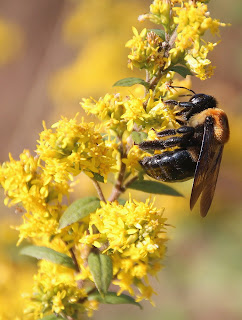 |
| Bumblebee on goldenrod |
 |
| Trail through goldenrod and little bluestem |
 |
| A few aspens; there are others growing nearby at the edge of the meadow |
 |
| Native little bluestem (Schizachyrium scoparium) |
 |
| Bluebird box on meadow slope |
 |
| Goldenrod (Solidago spp.), boneset (Eupatroium perfoliatum) and native grasses |
The result has been mixed in my opinion. First, I have to admit that I don't know if the "target" birds have returned to the meadows. If they have, they've "voted with their wings" and given the restoration their approval. But, if the birds haven't returned, the project cannot automatically be dubbed a failure because (1) they birds may not have "found" the meadows yet, (2) the habitat may not have developed enough to interest the birds, or (3) the restored field really might not be suitable habitat.
 |
| This section of the meadows almost looks "western," with a big rock and conifers |
In addition, the meadows are small and fragmented. Some meadow-nesting birds seem to need 160 acres of grassland habitat to breed successfully, and these fields are nowhere near that large. Other species, especially species that like brushy habitat, may be the first ones to recolonize the site. To my eye, the habitat looks perfect for birds that like scrubby, brushy habitat.
 |
| Deer exclosure fencing |





4 comments:
I wonder who managed the restoration project. Maybe they needed more input from people with a better understanding of the requirements.
The shot with the large stone does look like a scene from somewhere out West.
I really appreciate seeing this and reading your commentary on it. I like your analysis and how you evaluate the efforts to restore this habitat. I would never notice the details that you see, and I am enlightened by your knowledgeable perspective. Thank you for that.
Mark: The fellow who manages the Houston Meadows project is actually a former employee of mine. He knows his stuff. I'm just afraid that the vagaries and constraints of city politics may have gotten in the way of making this a great project.
By the way (apropos nothing), the first time I visited this site, just before restoration work was to begin, I got a terrible case of chiggers. It's the only time I've ever gotten chiggers in the East, and none of my colleagues who were with me in the fieled that day got the buggers. My luck!
Robin Andrea: Thank you for your kind comments. I've been doing this for 28 years now, so I'd better at least appear to know what I'm doing!
Post a Comment